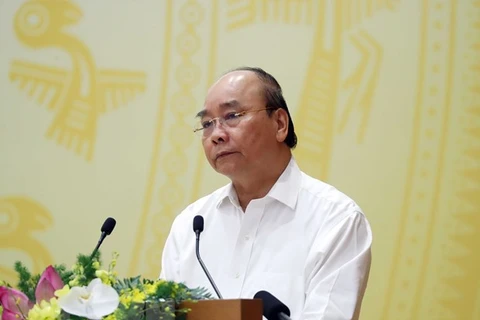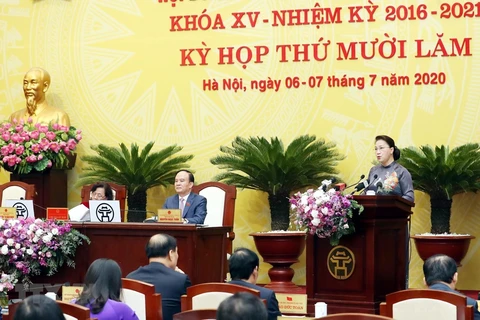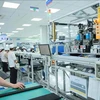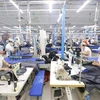Hanoi (VNA) – The reopening of the tourism sector and the resumption of industrial production back to normal affirms that Vietnam has spectacularly overcome COVID-19 and is ready to become a regional economic hub, Economic Professor Pankaj Jha has assessed in his recent article posted in website moderndiplomacy.eu.
VietnamPlus e-newspaper would like to introduce his full article titled “Opportunities for Vietnam’s economy in post COVID-19 phase.
“The opening up of the tourism sector and resuming of normal industrial production affirms that Vietnam spectacularly overcame COVID-19 and is now ready to become a regional economic hub that can replace China in the global supply chain in select sectors. Despite the global trend of recession, the IMF report in April 2020 has predicted that Vietnam will grow at a rate of 2.7 percent, which would be higher than many other regional economies. However, it was predicted that the inflation would also be more than 3 percent which would still be in manageable levels. At comparative levels, countries such as the Philippines and Indonesia would be growing at 0.6 and 0.5 percent in the year 2020. The big economies-Thailand and Malaysia would be contracting. In the midst of the COVID-19, Vietnamese PM Nguyen Xuan Phuc said in May 2020 that Vietnam’s economy would be growing by more than 2.7 percent.
Following its report in April 2020, IMF revised its estimates in May 2020 and stated that in the year 2021 the Vietnam’s economy would be growing at 7 percent which clearly means that the economy would have recovered from the adverse effects of COVID-19 in the year 2020 only. The reasons which have been provided by the IMF included sound economic fundamentals, and growth in merchandise exports. This has also been because of the fact that Chinese economy would suffer because of the COVID-19. Forbes has predicted that Vietnam is one of the safest countries for COVID-19 travel because of effective measures. The country recorded only 331 cases of infection with no deaths reported because of the virus. This has been lauded at the international level.
In order to promote growth and boost the tourism sector, the government has initiated easy facilitation of investment and even proposed a cut in corporate income tax up to 30 percent to boost investment. The Vietnamese national legislature has been discussing the proposal to promote investment in private companies, small and medium enterprises (SMEs) as well as public enterprises. The purpose of this proposal is to provide considerable tax benefits and even deferred tax payments. The SMEs comprise nearly 97 percent of total business in Vietnam. This kind of incentive would promote capital consolidation, skilled labour, and induction of technology at lower levels. The one essential criteria is that the businesses must show that they have suffered losses in their current financial year. Further, China has been witnessing a recessionary trend in textile and apparel exports because of low demand in Europe. This might augur as an advantage for Vietnamese exports.
Vietnam has been targeting international manufacturers to shift production after the Free Trade Agreement (FTA) between the European Union and Vietnam. Following the formal ratification of the FTA by EU which is expected to be in August, the trade benefits that Vietnam will reap will be huge. After Singapore, Vietnam is the only country in Southeast Asia to have a trade treaty with the European Union. The Vietnam-EU trade agreement will facilitate entry of 71 percent of Vietnamese goods, tariff free to Europe, while 65 percent of goods from European Union would enter Vietnamese market without any tariffs. Vietnam hopes that this trade agreement would wean away the primacy of Chinese manufacturers particularly in footwear and apparel exports. Vietnam has been exporting nearly 42 billion USD worth of goods to Europe last year, and it is expected that this free trade agreement will boost Vietnamese economy by more than 2.4 percent. Vietnam is also looking for a free trade agreement with the US so as to capitalize on the anti-China sentiments in the US markets. It is expected that the quick turnaround in manufacturing of Vietnam would eat into Chinese export markets.
 EVFTA expected to open up more opportunities for trade exchanges between Vietnam and EU (Photo: VietnamPlus).
EVFTA expected to open up more opportunities for trade exchanges between Vietnam and EU (Photo: VietnamPlus). As an assurance to international investors, Vietnam has opened its tourism sector. Domestic visitors have been thronging the tourist spots to demonstrate that the country has come out of the COVID trap. For Vietnam, tourism accounts for nearly 9 percent of its 260 billion USD economy. Domestic tourists account for nearly 80 percent of all visitors, and it is expected that with the opening up of international flights and better deals in tourism sector, particularly in hotels and group tours, Vietnam might be reaping the windfall. With major tourist destinations such as Thailand and Singapore not being able to open up tourism sector at an early date, Vietnam might get diverted tourists from these destinations.
Even though the measures that have been taken by the Vietnamese government have been supportive of manufacturing and the tourism sector, several business sectors such as small shops, restaurants, cinema and other entertainment destinations have been affected. Until and unless the domestic demand is generated, a large number of Vietnamese workers could lose their jobs. It is expected that nearly 10.3 million workers could lose jobs or would have to work at a lower salary. The important aspect is that education, training and related infrastructure is also going to be affected.
Vietnam has already approved measures, particularly with regard to food availability with a 2.66 billion USD stimulus and has given the option of deferred payments for land use and tax submissions. One of the major areas that Vietnam has been looking into is to promote local shops, businesses, online marketing activities and promoting e-commerce. E-commerce and online marketing would promote packaging and distribution networks which will be an advantage for the manufacturing sector.
At an international level, online learning platforms and meeting apps have been widely appreciated and it is expected that Vietnam will also adopt these applications so as to promote vocational training and English learning among its students. It is also expected that the healthcare sector would also imbibe the IT solutions in areas such as telemedicine and video diagnostics. There is also a possibility of Virtual Reality (VR) investigation in serious cases. Vietnam very well knows that in case COVID-19 vaccine is discovered, then it can also start a production line for cheap manufacturing of those drugs. Vietnam has already made a mark with regard to PPE kits as well as other sanitation material. Vietnam can explore the possibility of producing low cost kits and medical equipment under joint venture with other countries. The importance of long term business visas and promoting easy trade facilitation along with single window clearance for FDI would usher a boom time for the Vietnamese economy.
During this time the structure and support of the government along with tax incentives, easy bureaucratic procedures, and capital acquisition through FastTrack processes would mean that Vietnam would emerge as the fastest growing economy in Southeast Asia. It needs to be seen whether Vietnam can capitalize in these adverse circumstances and make corrective measures to pave the pathway for a double digit growth in the next decade”./.
























